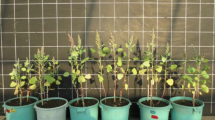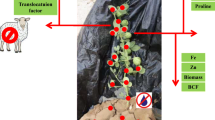Abstract
In this study, we clarified the accumulation and concentration of Cs, Na, and K in each organ (leaves, stem, and panicle) of quinoa (Chenopodium quinoa Willd.) under NaCl application condition. Pot experiments using Wagner pots (1/5000a) were conducted in an experimental field at Nihon University in 2018 and 2019, using quinoa variety CICA-127. The growth of quinoa as well as Cs accumulation and concentration was promoted by increasing the amount of NaCl applied. Quinoa accumulated most of the Cs in the leaves, and it was not translocated from the leaves to panicle after the seed filling stage. Cs accumulation by the aboveground parts under NaCl application was at least four times higher than that in the control. Accumulation of Na in stem was highest among organs. The quinoa plants had the mechanism to accumulate Na in the stem. Quinoa has bladder cells on the leaf surface, and excess Na accumulates in these cells. It is unknown whether bladder cells are present on the surface of the stem. Since Cs and Na inhibited the growth of plants, it is necessary to clarify the suppression method of stunting by Cs and Na. Thus, we believe that quinoa can be used for phytoremediation of Cs. Quinoa varieties with high Cs absorption need to be selected for effective phytoremediation in the future experiment.
Similar content being viewed by others
References
Adams, P., Nelson, D. E., Yamada, S., Chmara, W., Jensen, R. G., Bohnert, H. J., & Griffiths, H. (1998). Growth and development of Mesembryanthemum crystallinum (Aizoaceae). New Phytologist, 138, 171–190.
Adams, E., Abdollahi, P. & Shin, R. (2013). Cesium inhibits plant growth through jasmonate signaling in Arabidopsis thaliana. International Journal of Molecular Sciences, 14(3), 4545–4559.
Adams, E., Chaban, V., Khandelia, H., & Shin, R. (2015). Selective chemical binding enhances cesium tolerance in plants through inhibition of cesium uptake. Scientific Reports, 5, 1–10.
Adolf, V. I., Jacobsen, S. E., & Shabala, S. (2013). Salt tolerance mechanisms in quinoa (Chenopodium quinoa Willd.). Environmental and Experimental Botany, 92, 43–54.
Agarie, S., Shimoda, T., Shimizu, Y., Baumann, K., Sunagawa, H., Kondo, A., Ueno, O., Nakahara, T., Nose, A., & Cushman, J. C. (2007). Salt tolerance, salt accumulation, and ionic homeostasis in an epidermal bladder-cell less mutant of the common ice plant Mesembryanthemum crystallinum. Journal of Experimental Botany, 58(8), 1957–1967.
Broadley, M. R., Willey, N. J., & Mead, A. (1999). A method to assess taxonomic variation in shoot caesium concentration among flowering plants. Environmental Pollution, 106, 341–349.
Chino, M., Nakayama, H., Nagai, H., Terada, H., Katata, G., & Yamazaki, H. (2011). Preliminary estimation of release amounts of 131I and 137cs accidentally discharged from the Fukushima Daiichi nuclear power plant into the atmosphere. Journal of Nuclear Science and Technology, 48, 1129–1134.
Dushenkov, S., Mikheev, A., Prokhnevsky, A., Ruchko, M., & Sorochinsky, B. (1999). Phytoremediation of radiocesium-contaminated soil in the vicinity of Chernobyl, Ukraine. Environmental Science & Technology, 33, 469–475.
Flowers, T. J., & Yeo, A. R. (1995). Breeding for salinity resistance in crop plants: where next? Australian Journal of Plant Physiology, 22(6), 875–884.
Fujii, K., Ikeda, S., Akama, A., Komatsu, M., Takahashi, M., & Kaneko, S. (2014). Vertical migration of radiocesium and clay mineral composition in five forest soils contaminated by the Fukushiuma nuclear accident. Soil Science & Plant Nutrition, 60, 751–764.
Furukawa, J. (2014). The terrestrial environmental dynamics of radioactive nuclides released by the Fukushima nuclear accident. Yakugaku Zasshi, 134(2), 143–148.
Gupta, B. & Huang, B. (2014). Mechanism of salinity tolerance in plants: physiological, biochemical, and molecular characterization. Int. J. Genom., 2014, Article ID 701596, 18 pages.
Hampton, C. R., Bowen, H. C., Broadley, M. R., Hammond, J. P., Mead, A., Payne, K. A., Pritchard, J., & White, P. J. (2004). Cesium toxicity in Arabidopsis. Plant Physiology, 136, 3824–3837.
Hayakawa, T., & Kurihara, H. (2002). Trial for phytoremediation on the heavy metal pollution. Journal of Environment and Biotechnology, 2, 103–115.
Hirayama, T. (2012). Transfer of radiocesium in soil to konnyaku and behavior of radiocesium in production process of konnyaku powder. Tohoku Agric. Res., 65, 83–84.
Hirayama, T., Suzuki, Y., Saitou, T., Sato, M., Kobayashi, H., Takahashi, Y., Kato, H., & Yakushido, K. (2012). Phytoremediation effects of radiocesium in soil by use of sunflowers. Jpn.J. Crop Science, 81(2), 18–19.
Hirayama, T., Keitoku, S., & Yoshioka, K. (2013). Sequential changes of uptake of radio-cesium in soil to rape seeds. Crop Science Society of Japan Lecture summary, 235, 242.
Horie, T., Kaneko, T., Sugimoto, G., Sasano, S., Panda, S. K., Shibasaka, M., & Katsuhara, M. (2011). Mechanism of water transport mediated PIP aquaporins and their regulation via phosphorylation events under salinity stress in barley roots. Plant & Cell Physiology, 52, 663–675.
Ii, I., Tanoi, K., Uno, Y., Nobori, T., Hirose, A., Kobayashi, N., Nihei, N., Ogawa, T., Tao, Y., Kanno, M., Nishiwaki, J., & Mizoguchi, M. (2015). Radioactive caesium concentration of lowland rice grown in the decontaminated paddy fields in Iitate-Vallage in Fukushima. Radioisotopes, 64, 299–310.
Isobe, K., Ogishima, E., Sato, R., Sugiyama, H., Higo, M., & Torigoe, Y. (2014). Varietal and specific differences in salinity tolerance of quinoa (Chenopodium quinoa Willd.) for germination and initial growth. Japanese Journal of Crop Science, 83, 9–14.
Isobe, K., Nakajima, E., Morita, M., Kawakura, S., & Higo, M. (2019). Effects of NaCl on growth and cesium absorption in quinoa (Chenopodium quinoa Willd.). Water, Air, and Soil Pollution, 230, 66.
Khan, M. A., Ungar, I. A., & Showalter, A. M. (2000). Effects of salinity on growth, water relations and ion accumulation of the subtropical perennial halophyte. Atriplex griffithii var. stocksii. Annals of Botany, 85, 225–232.
Kobayashi, N. I., Yamaji, N., Yamamoto, H., Okubo, K., Ueno, H., Costa, A., Tanoi, K., Matsumura, H., Fujii-Kashino, M., Horiuchi, T., Nayef, M. A., Shabala, S., An, G., Ma, J. F., & Horie, T. (2017). OsHKT1; 5 mediates Na+ exclusion in the vasculature to protect leaf blades and reproductive tissues from salt toxicity in rice. The Plant Journal, 91, 657–670.
Krishnamurthy, P., Jyothi-Prakash, P. A., Qin, L., He, J., Lin, Q., Loh, C. S., & Kumar, P. P. (2014). Role of root hydrophobic barriers in salt exclusion of a mangrove plant a vicennia officinalis. Plant, Cell and Environment, 37, 1656–1671.
Kubo, K., Fujimura, S., Kobayashi, H., Ota, T., & Shinano, T. (2017). Effect of soil exchangeable potassium content on cesium absorption and partitioning in buckwheat grown in a radioactive cesium-contaminated field. Plant Production Science, 20(4), 396–405.
Menzel, R. G., & Heald, W. R. (1955). Distribution of potassium, rubidium, cesium, calcium, and strontium within plants grown in nutrient solutions. Soil Science, 80(4), 287–294.
Ministry of Agriculture, Forestry and Fisheries of Japan (2013). Technical document for decontamination measures for farmland, (Part 1 Survey/Design), 1—57.
Miyahara, S. (2014). Surface soil scraping by agricultural tractors for farm land decontamination. Japanese Society of Soil Science and Plant Nutrition, 85, 125–128.
Nishioka, H., Momose, T., Inoue, D., Fujiwara, K., Kitajima, T., Ohno, S., Tanaka, M., & Suzuki, T. (2011). Surface structures induced by alkali metal (K, Cs) adsorption on Si (111) -clusters observed for adsorbate coverages close to the saturation coverage. Journal of Surface Science Society of Japan, 32, 302–307.
Ogata, N., Fujita, T., & Kato, M. (2015). Phytoremediation of radioactive cesium contaminated soil by cultivation Amaranthus spp. Japanese Journal of Crop Science, 84(1), 9–16.
Poustini, K., & Siosemardeh, A. (2004). Ion distribution in wheat cultivars in response to salinity stress. Field Crops Research, 85, 125–133.
Sabbarese, C., Stellato, L., Cotrufo, M. F., D’Onofrio, A., Ermice, A., Terrasi, F., & Alfieri, S. (2002). Transfer of 137Cs and 60Co from irrigation water to a soil-tomato plant system. Journal of Environmental Radioactivity, 61(1), 21–31.
Saleem, M. A., Basra, S. M. A., Afzal, I., Rehman, H. U., Iqbal, S., Saddiq, M. S., & Naz, S. (2017). Exploring the potential of quinoa accessions for salt tolerance in soilless culture. International Journal of Agriculture and Biology, 19, 233–240.
Sato, M. (2014). Verification of radiocesium removal by phytoremediation. Japanese Journal Soil Science and Plant Nutrition, 85, 136–137.
Shimizu, K., Cao, W., Abiko, N., Ishikawa, N., & Hamamura, K. (2008). Slat tolerance of Suaeda japonica M. and use in salt-affected lands. Trop Agr Develop, 52(1), 1–6.
Soudek, P., Valenova, S., Vavrikova, Z., & Vanek, T. (2006). (137)Cs and (90)Sr uptake by sunflower cultivated under hydroponic conditions. Journal of Environmental Radioactivity, 88, 236–250.
Tamaoki, M., Yabe, T., Furukawa, J., Watanabe, M., Ikeda, K., Yasutani, I., & Nishizawa, T. (2016). Comparison of potentials of higher plants for phytoremediation of radioactive cesium from contaminated soil. Environmental Control in Biology, 54(1), 65–69.
Tanoi, K., Kobayashi, N. I., Ono, Y., Nakanishi, T., Nemoto, K., & Fujimura, S. (2013). Radiocaesium distribution in rice plants grown in the contaminated soil in Fukushima Prefecture in 2011. Radioisotopes, 62, 25–29.
Tsukada, H., Hasegawa, H., Hisamatsu, S., & Yamasaki, S. (2002). Rice uptake and distributions of radioactive 137Cs, stable 133Cs and K from soil. Environmental Pollution, 117, 403–409.
Tuteja, N. (2007). Mechanisms of high salinity tolerance in plants. Methods in Enzymology, 428, 419–438.
Watanabe, Y. (2014). Burying radioactive cesium-contaminated soil by ploughing. Japanese Society of Soil Science and Plant Nutrition, 85, 129–131.
White, P. J., & Broadley, M. R. (2000). Mechanisms of caesium uptake by plants. New Phytologist, 147, 241–256.
Yamauchi, M., Matsumoto, N., Maeda, Y., & Nagai, T. (1986). The relations between salt tolerance and the characteristics of sodium absorption and distribution in cuculbitacea plants. Bulletin of the Faculty of Agriculture, Tottori University, 39, 12–18.
Zhu, Y. G., & Smolders, E. (2000). Plant uptake of radiocaesium: a review of mechanisms, regulation and application. Journal of Experimental Botany, 51, 1635–1645.
Author information
Authors and Affiliations
Corresponding author
Additional information
Publisher’s Note
Springer Nature remains neutral with regard to jurisdictional claims in published maps and institutional affiliations.
Rights and permissions
About this article
Cite this article
Wada, K., Takagi, R., Horikoshi, M. et al. Effects of NaCl Application on Cesium Accumulation in the Aboveground Parts of Quinoa (Chenopodium quinoa Willd.). Water Air Soil Pollut 231, 552 (2020). https://doi.org/10.1007/s11270-020-04926-y
Received:
Accepted:
Published:
DOI: https://doi.org/10.1007/s11270-020-04926-y




